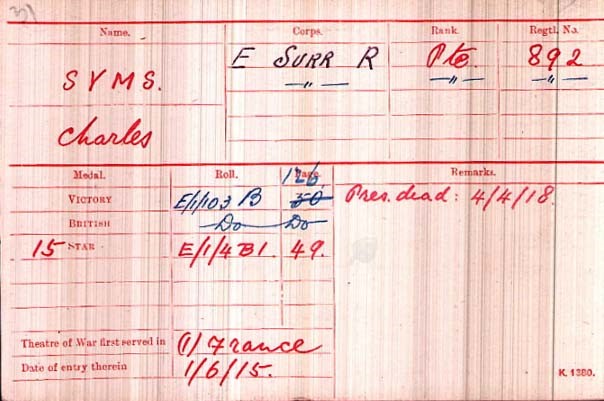CHARLES SYMS
Private, 892, 7th East Surrey Regiment
Killed in Action near Amiens, France, 4 April 1918
Buried at Viller-Bretonneux Military Cemetery, France
Plot 15, Row E, Grave 3
Charles Syms was born in Bromley-by-Bow, London E3, in 1892, the second child of Montagu and Mary Ann Syms (née Campin). The family had moved around a fair bit; the parents came from London and Buckinghamshire, but had married at Holmwood in Surrey. Montagu gave his occupation as dairy man, but his father was a solicitor's clerk. Older daughter Emily was born in Sutton and younger daughter Doris at Paddock Wood. In 1891 they were all living at Sea View Cottages in Capel le Ferne near Folkestone, where Montagu was a dairy foreman. By 1911 they had moved to Trimmers Pond in Forest Row, and Montagu was now a milkman. Charles, aged 19, was working as a gardener.
Charles Syms enlisted in the army at Weybridge, and although there is no record as to when, his medal card shows that he was sent to the Western Front on 1 June 1915. To begin with, he was part of the 7th Battalion of the East Surrey Regiment, but was later moved to the 8th, presumably when the 7th was disbanded. A letter to Lieutenant-Colonel L D Scott of the 7th Battalion dated 4 February 1918 at the end of the War Diary gives some flavour of the action Syms may have seen:
During my command of the Division, the 7th Battn. East Surrey Regiment has always distinguished itself by its fine fighting qualities, and by its smartness and excellent discipline. From the fighting at THE QUARRIES in October, 1915, to that at CAMBRAI in November 1917, the Battalion has invariably done well, and I have at all times felt the greatest confidence that it would carry out its task with dash and gallantry.
On the day of Charles Syms' death, the entry in the 8th Battalion war diary is long and detailed. It begins at 5 a.m. with heavy shelling including gas and smoke shells, which stopped after half an hour and then recommenced at 6 o'clock. The weather was poor, with rain falling incessantly all morning, which made it hard for the men to keep rifles in good working order, and at 6.30 they suffered an infantry attack. By mid-morning:
The men's clothes and hands were covered with liquid mud and the mere action of inserting a fresh clip in the magazine entailed a certain amount of mud being inserted with it. Lewis guns, in particular, presented an almost impossible task, although the gunners did their best to keep them clean...one man even tore up the tail of his shirt in order to clean his gun.
Fighting continued all day, and casualties were heavy. One of the many killed in the chaos was Charles Syms, and given the description of the day's action, it is not surprising that his medal card notes that he was 'presumed dead'. Although he has a marked grave, with the inscription:
He has fought the good fight
it seems probable that his body was lost in the mud and was unidentifiable.

Charles Syms' medal card
The Viller-Bretonneux Cemetery, designed by Lutyens, is the resting place for over 1500 identified casualties of the First World War, many of them belonging to Commonwealth forces, but also to another 600 who were never identified.
By the time his mother submitted his details for the Forest Row Memorial Book, his parents were living at 3, Carlton Terrace in Forest Row. The Commonwealth War Graves site has the couple living at 99 Queen's Road East Grinstead, which is possibly a later address.
Charles' father Montagu died in 1931, in the East Grinstead registration district; his mother's death has not been found.
Pam Griffiths
1 March 2018

